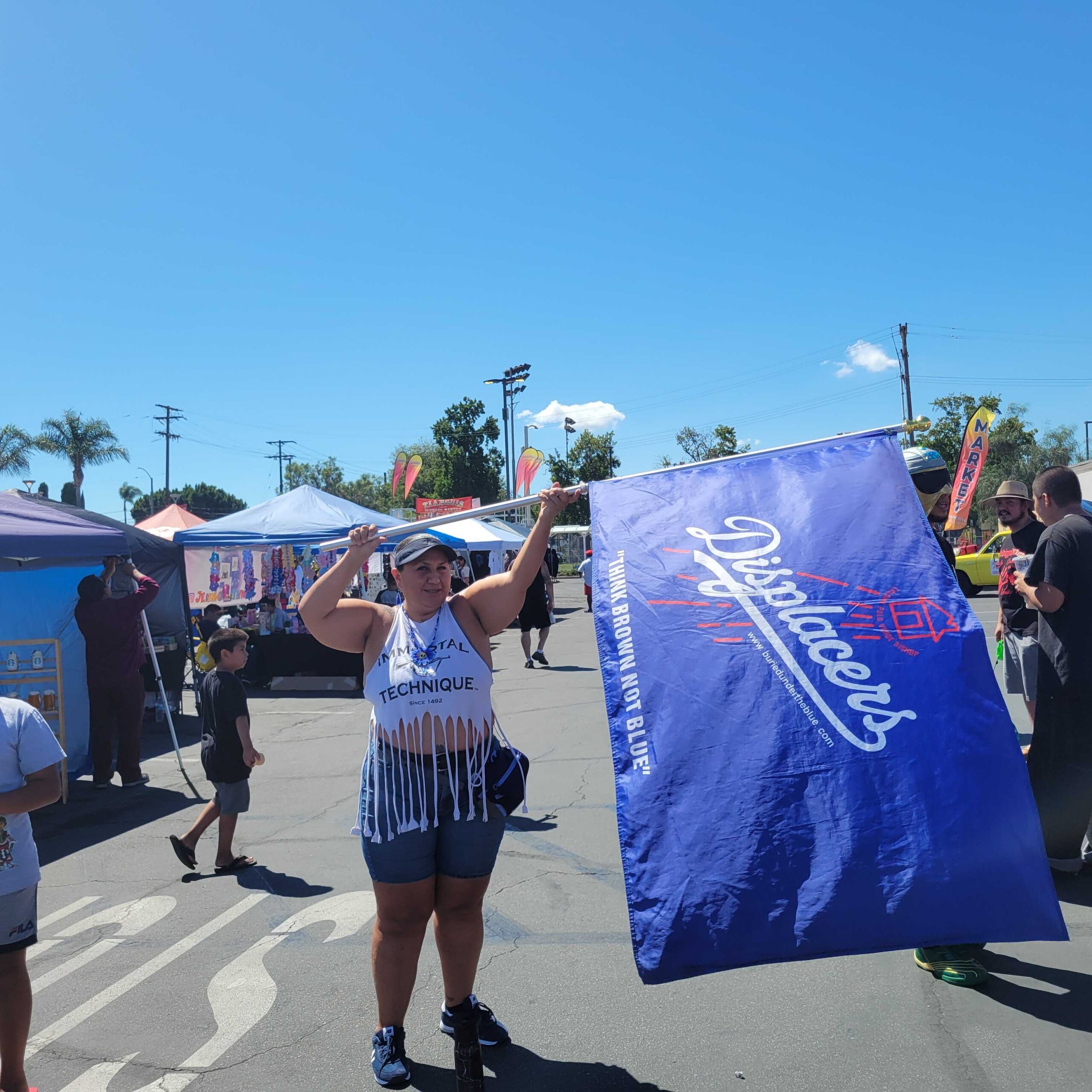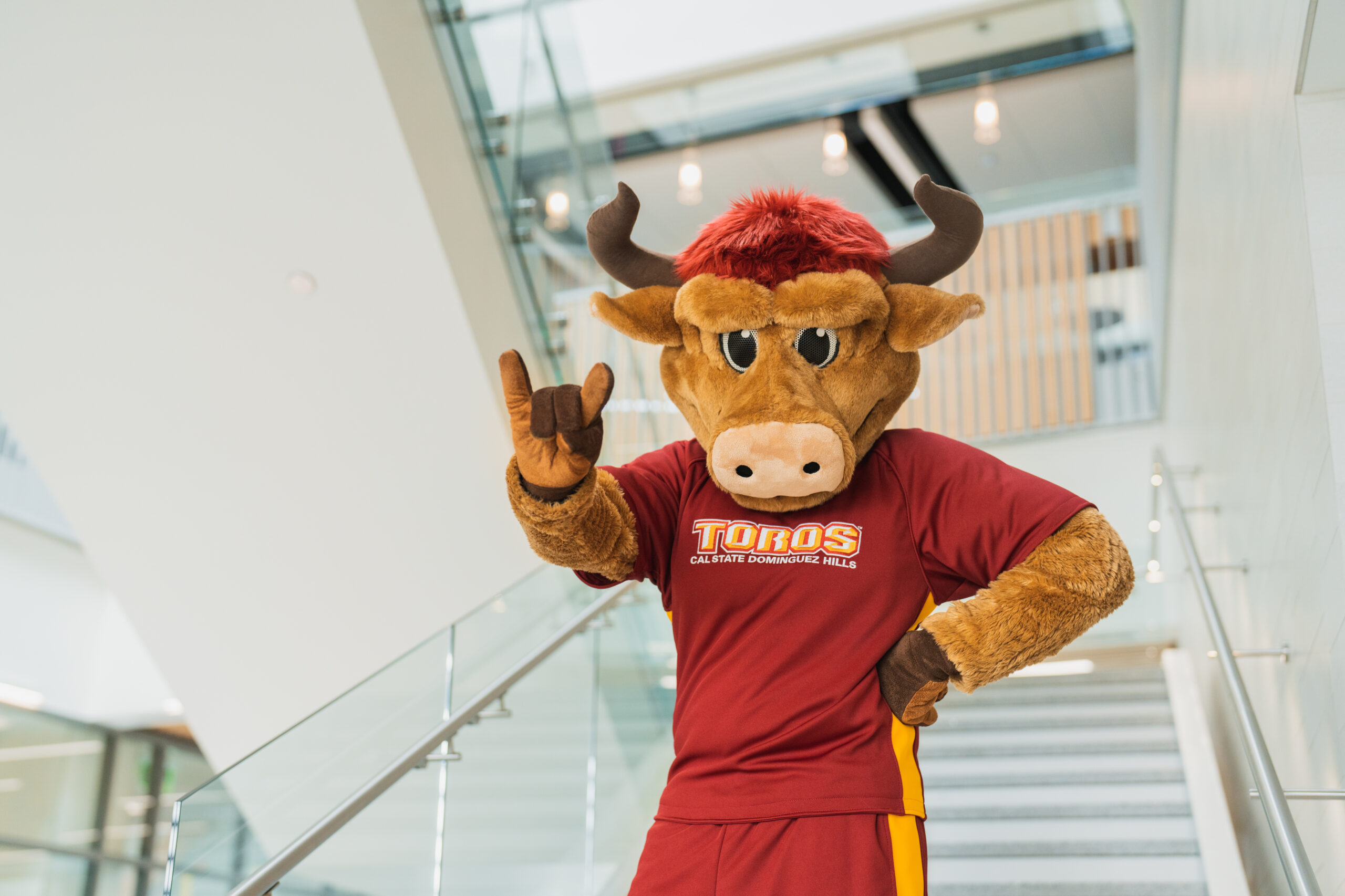Melissa Arechiga, a founder of Buried Under the Blue waves the Displacers flag and speaks to attendees of the Tianguis Market at Long Beach City College. Photo by Marcelo Maximilian.
By Marcelo Maximilian Staff Reporter
Cheryl Blackhawk, a business administration and marketing major at California State University, Dominguez Hills raises her hand in the front of her class and actively participates in her Native American & Chicana women’s narrative lecture discussions. As a registered member of the Otoe Missouria tribe with ancestry belonging to the Shoshone Paiute tribes, her personal story of her family history on North American soil adds context to the course material.
“My Ancestors have been through a lot of government-issued mental and physical atrocities by a group who wanted nothing more than land to build their wealth,” said Blackhawk who experienced displacement by eminent domain. Blackhawk had to evacuate her Gardena home because it was on the two blocks of land CalTrans needed to build a Park-n-Ride location through Metro and an on-ramp for the interstate 110 freeway.
“It was our community, but they didn’t care so they gave the money and we moved,” said Blackhawk, who originally moved to northern California but returned to southern California after her children experienced racism. “My Ancestors have been through a lot of government-issued mental and physical atrocities by a group who wanted nothing more than land to build their wealth.”
Blackhawks’ mother was one of 13 children living on a reservation in a rural town in Nevada. She was forced to leave her parents at the age of 13 when she was placed in the Sherman Indian School in Riverside, CA. After graduating, she continued to live in California seeking better opportunities and was sworn into the United States Navy as a civilian employee in response to Pearl Harbor. Although Blackhawk’s mother took an oath of allegiance, she was denied a Veterans’ memorial.
On the family’s 160-acre plot of land in Nevada, her mother lived in a two-bedroom home where they planted hay and owned chickens, cows, horses and had an apple orchard. Blackhawk described the present-day land as limited to one post office, a hospital funded by Indian Health Service, a courthouse, police, and a fire department. She said the reservation has a tribal complex that addresses fish and game, water irrigation, and tribal economy.
“They are in turmoil right now because half want a casino and half do not. This conflict has been going on for years. They do not want anyone else on their land or in their community,” Blackhawk said.
In 1928, the Merriam Report exposed the poverty, death, health crises and corruption of the Indian boarding school system. The Great Depression happened shortly after the report, and as the country declined, it was during President Franklin D. Roosevelt’s “New Deal” era when the Indian Reorganization Act (IRA) was created. The most notable takeaway from the IRA was the encouragement of tribes to exercise their self-governing power.
Blackhawk is just one example of how Los Angeles has displaced people of color. The group Buried Under Blue is led by the living ancestors of La Loma, Bishop and Palo Verde, the three communities that were on the land prior to the Dodger Stadium, according to the group. Their mission is to preserve the history of the three communities through education.
A traumatic encounter with the police was fuel for fellow memberEdin Enamorado to explore a career path in social justice. “We were bald-headed; always getting harassed by cops, to me it was whatever, but when one of the officers interlocked my fingers, he broke my finger, that’s when I started running my mouth and they beat me up pretty bad,” said Enamorado who in addition to the broken finger, also suffered from a fractured back and concussion.
Enamorado recalled situations where he remained calm as he was pulled over and profiled by police, but this time, he fought for justice. “It woke up a monster because I just felt that it wasn’t their first time doing that, so we got together as a community and attended the city council meeting and look deeper into the police department, it turned out they were all bad apples,” Enamorado said.
Six months after the incident, the Cudahy police department disbanded, and the officers involved were fired and replaced with sheriffs. The outcome became a new awakening for Enamorado.
“That opened my eyes…we can actually make a change and have these small victories that affect our lives,” said Enamorado.
Enamorado, who is currently a Cudahy, CA resident, was one day handed a sticker at a concert reading “Displacers.” The sticker led him to the Buried Under the Blue organization. Thirty-three years as a Dodgers fan came to an end as Enamorado went from watching his team on the field to being on the field as an activist. Right before the 7th inning stretch, Enamorado ran onto the field with other protestors. Enamorado was inspired by YouTube personality Vitaly, who ran onto the pitch mid-game during the World Cup in Brazil.
“I came up with the idea of running on the field for years, they’ve been trying to get the attention of the city council and Dodgers,” said Enamorado “Why not disrupt their circus?”
Enamorado and the two other runners were tackled and detained for about four hours, and although the DA dropped their charges and they did not have to pay a fine, they were banned from the stadium for the next five years.
The Buried Under the Blue organization run by supporters and the grandchildren of the earlier generations who lived on the land are protesting the stadium with such as; raising their banners with their logo on busy Los Angeles freeways, waving their flag in the stadium during games, and even running on the field during games in protest of displacement. Buried Under the Blue, tells the history of families being forcibly and physically carried out by the Los Angeles County Sheriff.
“We want to own our stories of the three communities because it derives from the history of colonization and today, we refuse to give up that story to the colonized world to tell lies about it,” said Vincent Montalvo, board of directors member with the Buried Under the Blue organization.
Montalvo, a current resident of Echo Park, dressed in a spoof “Dodger” blue shirt which if seen from afar can be easily mistaken for legitimate Dodgers merchandise. The word “Displacers” is written in the same font in place of the word “Dodgers” and a house replaces the Dodger baseball with the three communities listed below; La Loma, Bishop, and Palo Verde.
Palo Verde was the community where Montalvo’s grandparents were born and raised, where they met each other and started their families until 1959.
“We come from good culture. Our culture wasn’t just good, it was intelligent, and that’s why it was destroyed. None of the stories were told that lead up to what we see today in our three communities,” said Montalvo whose grandmother passed down his family history to his mother.
The shared experience of being displaced in Los Angeles is a heartbreaking reminder of the land that Blackhawk and the founders of the Buried Under the Blue organization lost. The cycle of being displaced due to the eminent domain has been a devastating reality for Angelenos in the past and the hurt continues to roll into today.



